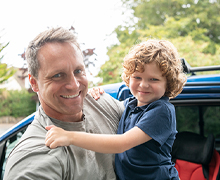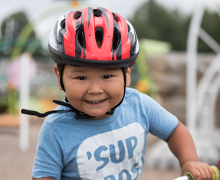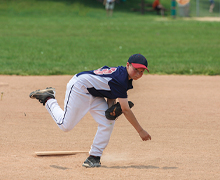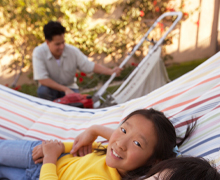Spring 2022
For All Parents, It’s Normal to Feel Frustrated
 If you’re a parent, you know what frustration feels like. Regardless of your situation — partnered or single, working or stay-at-home — frustration can be a familiar and frequent sensation.
If you’re a parent, you know what frustration feels like. Regardless of your situation — partnered or single, working or stay-at-home — frustration can be a familiar and frequent sensation.
Many parents find themselves getting frustrated more easily and more often than compared to a few years ago. That’s not surprising, as some long-term effects of the pandemic are now hitting home. Parents may be stressed about big issues like jobs, money and housing. Plus, they’re worried about their kids’ emotional wellbeing, social skills and learning milestones.
Self-care is crucial for everyone, and especially for stressed-out parents. It doesn’t have to be indulgent or expensive — not everyone can swing a spa day or a yoga retreat. Basic self-care means eating healthy foods, exercising regularly, enjoying favorite hobbies, spending time alone and connecting with close friends. It also means reaching out for help and support, like trading childcare duties with another parent so you get some time to yourself, confiding in a trusted friend, attending a workshop or webinar, or talking with your doctor or counselor.
Parenting offers plenty of frustration triggers, including crying infants, willful toddlers, surly teens and the extra attention a child with special needs can require. In any case, it’s important to recognize frustration as soon as you feel it creeping up. Then, take action to prevent it from growing so you don’t say or do anything unkind.
One powerful technique is the ‘Take 5’ method, which you can teach your child, too! Here’s the five-step method:
- Stop. Step away. Give yourself space.
- Take a short break to breathe. Allow your heart rate to return to normal.
- Remind yourself I can do this or It’s important to stay calm.
- Ask yourself How can I handle this situation in a way that I will feel good about?
- If possible, ask for support from a partner or family member, or call or text a friend or neighbor.
Another great resource especially for parents of children with special needs is Parent-to-Parent (P2P), whose services include free, one-on-one support from volunteer peer mentors — parents who’ve been through similar trials. To learn more about P2P in Washington state, visit their website or call 1-800-821-5927.
Peaceful parenting is about keeping a calm spirit and an open, loving heart: you’ve got this!
Car Seats for Children with Behavior Challenges
 When a child has conditions that make it hard for them to stay buckled in their car seat, some specialty equipment may be needed to keep them safe. Resources are available.
When a child has conditions that make it hard for them to stay buckled in their car seat, some specialty equipment may be needed to keep them safe. Resources are available.
With help from medical professionals, you may be able to get a specially designed car seat or safety vest that is comfortable and prevents escape. These items can be purchased directly or ordered through some insurance plans.
Start by sharing with your child’s doctor that you’re having a car safety issue so they can refer you to a behavioral or occupational therapist (OT). Some OTs can complete a car seat evaluation and help you get the best equipment for your child.
Learn more about car seat options for children with behavior challenges.
When Should My Child Wear a Life Jacket?
 When a child between the ages of 1 and 14 dies from an unintentional injury, drowning is very often the cause. Only motor-vehicle crashes claim more young lives.
When a child between the ages of 1 and 14 dies from an unintentional injury, drowning is very often the cause. Only motor-vehicle crashes claim more young lives.
Wearing a life jacket is the simplest, surest way to stay safe in and near the water. All children and teens should wear a life jacket any time they are on a boat, raft or other floating device. They should also wear one when swimming in open water such as lakes, rivers or the ocean.
Children ages 6 to 11, in addition to the previous rules for all children and teens, should also wear a life jacket while on docks and river banks, in case they fall in.
Children from birth to age 5 should wear a life jacket anytime they are in, on or even near water, including on a beach or dock.
Many of those who die from drowning never even mean to get wet — they accidentally fall in. Life jackets save lives, but they only work when they’re worn and fit well. Be sure your child is protected!
Get more water safety tips.
Family Meals Are Fulfilling in Many Ways
 Family meals are about much more than eating together. Beyond sharing food, they’re a time to catch up and connect — to share stories, ideas, emotions, struggles and victories.
Family meals are about much more than eating together. Beyond sharing food, they’re a time to catch up and connect — to share stories, ideas, emotions, struggles and victories.
Family meals also offer a natural way to practice life skills like responsibility and teamwork — from helping with meal planning, grocery shopping and preparation to setting the table and cleaning up afterwards. And speaking of life skills, the family table is an ideal place to teach the value of a grateful and optimistic attitude, simply by having everyone share something for which they’re thankful or glad.
On top of all these benefits, studies show that families who regularly eat together tend to have more nourishing meals, and their children are less likely to engage in risky behaviors.
To ensure that you’re fully focused on one another, be sure that your table is completely screen-free for adults as well as kids. And while family meals are a time to model and teach table manners, they don’t have to be fancy or fussy. They can be casual and fun — no tablecloth required. Better yet, why not make a tablecloth of plain butcher paper and offer colored pencils so everyone can create some art while you enjoy your meal and conversation?
Kids’ activities and parents’ work schedules can make family meals challenging to plan, but it’s worth keeping them a top priority. At times, you’ll need to be flexible and creative — everyone loves a weekend brunch or a backyard picnic lunch, or even a tailgate pizza dinner after the big game. As long as you’re gathered together, that’s what counts!
Get more tips for healthy eating as a family.
Start the Helmet Habit Early
 Helmets that fit properly protect against head and brain injuries. Although it may be hard to imagine that a child could get a brain injury while on a tricycle or a mini scooter, it’s best to get into the helmet habit early. Children have an easier time developing healthy habits from a young age.
Helmets that fit properly protect against head and brain injuries. Although it may be hard to imagine that a child could get a brain injury while on a tricycle or a mini scooter, it’s best to get into the helmet habit early. Children have an easier time developing healthy habits from a young age.
Since kids respond to what they see and hear their parents do, be a faithful role model and always wear a helmet when you ride — and use praise and positive reinforcement when your child wears theirs.
Be sure your child’s other caregivers enforce helmet use, too. Learn how to choose a safe helmet that fits well.
Little League Shoulder
 When the growth plate in a child’s upper arm gets irritated, it’s known as Little League Shoulder. It can be caused by throwing too much or with poor form — or by muscle weakness around the shoulder and upper back.
When the growth plate in a child’s upper arm gets irritated, it’s known as Little League Shoulder. It can be caused by throwing too much or with poor form — or by muscle weakness around the shoulder and upper back.
Pitchers and catchers are at higher risk because they throw faster and more often than other positions. Symptoms include shoulder or arm pain, trouble moving the arm in all directions, and decreased speed or control while throwing.
To prevent injury, it’s important that kids throw using proper form. Also, before age 13, they should not throw curveballs, knuckleballs, sliders or screwballs. Parents can help by ensuring the coach sticks to pitch-count limits for their child’s age.
Lawnmower and Yard Safety
 Spring has arrived, and it’s fun for the whole family to be outside as much as possible — as long as everyone stays safe.
Spring has arrived, and it’s fun for the whole family to be outside as much as possible — as long as everyone stays safe.
When the lawn is being mowed, keep children under 5 inside or far away. Even after the mowing is done, keep them away from mowers: hot or sharp parts can cause injuries. Never allow kids to ride along on lawnmowers or in carts towed behind them.
To operate a push mower, children should be age 12 or older. Riding mowers should be operated only by those age 16 or older. For any lawnmowing, heavy boots are a must. It’s best to avoid using insect or weed killers; if you do, keep children out of the yard for at least 48 hours.
Get more warm weather safety tips.
Quick Tip
Encourage your child to learn about, name and accept their emotions.


